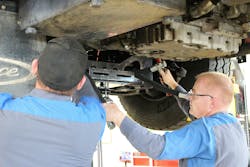Almost everyone knows someone who has, at one point or another, depended on a firefighter to help them during a frightening, uncertain time. Which means that almost everyone knows someone who has also counted on a firetruck to be ready and waiting.
For more on specialized work truck maintenance:
Which is why Matt Sims, southwest regional service director for Hughes Fire Equipment, always reminds the technicians he works with that “this truck could be coming to your house, so treat it like it is.”
Here’s how these technicians help make sure the fire apparatus we need are road-ready when the time comes.
Firetruck wear and tear and overall lifespan
Just like many commercial vehicles, the kind of wear and tear a firetruck experiences tends to depend on its duty cycle, but taken to the extreme.
“If you're in a smaller, usually more rural fire department, your department might run anywhere from 150 to 300 calls a year,” said Jeff Gaskin, president of Big Red Trucks Fire Apparatus. “And then you can go into more urban fire departments, [like] if you look at some of the bigger cities in the country, like New York, Los Angeles, Chicago, you have single vehicles that are answering 2,400, 2,500, 3,000 calls a year.”
Given this disparity, Gaskin explained that smaller departments might be looking at a 20- or 25-year lifespan for their engines, while those with higher duty cycles might be on the road for 10-15 years. The National Fire Protection Association (NFPA) standard 1900 agrees, stating that frontline vehicles should last for about 15 years before it could be upgraded and serve as a reserve engine, then should be retired after 25 years, said Greg Ward, assistant chief at Loveland Fire Rescue Authority (LFRA). Meanwhile, the LFRA specifically plans for an apparatus to spend 10 years on the front line and 5-7 in reserve for structural fire engines, and then 2-3 years as a training academy engine.
Part of the reason for the large difference in truck lifespans based on the size of the station is that firetrucks tend to wear a little differently than your standard over-the-road vehicles or commercial vehicles for two main reasons, Sims noted.
“Fire apparatus are fully loaded all the time,” he said, as they are almost always carrying a full crew, equipment, and water at all times. Then, of course, fire trucks operate in high-intensity situations, meaning they’re “pedal to the metal,” he added. All of this means that the suspension, brakes, tires, and engine tend to take more of a beating than in a typical truck.
Gaskin related that this means fire trucks tend to see more routine maintenance, including fluid and filter changes, tire changes, and brake work. Plus, once a truck does get to a scene, they tend to idle a lot, too, adding extra strain to the aftertreatment system overall, noted Corey Lane, senior emergency vehicle technician for the city of Loveland.
Preventative maintenance
Also, due to the various duty cycles, preventative maintenance can vary depending on the station’s activity, too, not to mention engine manufacturer guidelines and NFPA standards.
For instance, while Sims worked at a department, the engine manufacturer gave an oil-change guideline of 670, but the station’s PM standard was between 250-300 hours.
“So we kept that standard, and we just went to an every other [system] on the oil change,” Sims explained.
Similarly, Loveland’s Lane said that they do a 250-hour service, which might seem too often, but allows the department to do more thorough inspections, “which cuts down on big maintenance issues later on,” he said. More specifically, Loveland’s technicians tend to see a firetruck between three to four times a year, about three times for A Services (oil changes and safety inspections) and for a large annual inspection once a year. Plus, the engineers do daily and 30-day inspections as well.
The regular maintenance for A Services can include oil changes, engine oil and filter changes, chassis lubrication, transmission filter changes, and topping off antifreeze, Gaskin stated. Additionally, for the A Services, he advised that departments use the right equipment to suit the engines, such as a low-ash oil in the diesel engines and appropriate synthetic transmission fluid.
Another specialized aspect for firetruck PMs is regular equipment testing as recommended by the NFPA.
“It's not the law or anything, but the standard says that we do annual aerial testing [and] annual pump testing to ensure that the pump [is] moving to their rated capacity, and we're looking for any diminishing returns on any of those,” Sims noted. This testing also extends to voltage drop testing on relays and circuit breakers, and if there’s any drop in efficiency, they have to be replaced. “That’s unheard of anywhere but in the fire service,” Sims added.
Some fire stations also rely on oil sampling, as well as hydraulic tests for aerial systems, generators, or foam systems, Sims continued.
Faults to look out for
Due to their weight and how fire engines tend to drive, this can cause specific issues to crop up for trucks, especially in the suspension and electrical systems.
For suspension systems, fire departments are increasingly moving to air ride suspension systems because they’re cheaper to maintain, provide more stability while driving, and decrease wear and tear on the truck's body, said Warren Miller, shop supervisor for the City of Loveland. But this doesn’t mean that leaf spring suspensions have been fully phased out, meaning that fire department technicians need to keep an eye out for certain wear and tear.
“We actually do quite a few front springs on our apparatus, because [on] the packs, all the springs touch, and then you get a lot of corrosion issues in between,” Lane explained. “So it actually breaks the spring, not from being overloaded or overweight, but from the corrosion or delaminating and rustjacking.”
Then, Sims added that even with air suspension systems, technicians still need to keep an eye on a truck’s ride height, as failing to do so “can definitely lead to premature wear and tear on your suspension system.”
Then for electrical systems, fire engines also tend to see a lot more alternator and battery issues than OTR or vocational trucks, Gaskin said, just because they tend to put more loads on the electrical system between cab features and lights, AC, etc. This means that technicians always need to keep in mind the impact of those systems when running diagnostics.
For instance, Gaskin outlined a situation where a fire truck is running through batteries at a high rate. So, a technician might use a multimeter to test the alternator with the truck at idle and nothing on except the daytime running lights, finding that the truck is drawing 80-95A at idle, and the alternator is putting out 160-180A. This might indicate to the technician that the issue is something else entirely, since the alternator is meeting the truck’s needs.
“Well, that's great, but what the technician didn't do is he didn't turn on the emergency warning lights and he didn't turn on the air conditioning,” Gaskin explained. “So you turn those on, and you start to see that maybe the truck is now drawing 140 or 150 amps or more.”
Taking into consideration this 12V high-lumen scene lighting, plus the number of those lights turned on at night, plus idling and emergency warning lights and the AC, now the truck could be drawing 230-240A at idle, outstripping the alternator and causing the issue. And the solution to the problem?
“You change batteries and alternators,” Gaskin asserted, alongside teaching the crew to use the high-idle switch, which would boost alternator output, and train them to plug their trucks into shoreline power at home to keep the batteries charged. And in the specification phase, departments should understand the capabilities of various vehicle systems and the demands on the vehicle to avoid creating issues later.
Beyond electrical and suspension issues, firetrucks also tend to see problems with the compartment door as firefighters go in and out, as well as the overall corrosion from road salt. And the design of firetrucks can stress their components, too.
“One of our big issues is with the cabover design of a fire apparatus in these EGR engines, there's a lot of heat in the engine compartment, and heat really has nowhere to go,” Lane explained. “So we have a lot of problems with coolant hoses blowing or splitting, and our engine harnesses, the covering will get hard and brittle, and then we'll have wires rubbing on metal and causing a check engine light.”
This can require some specialized maintenance during annual inspections, including cleaning the EGR passages and the exhaust pressure sensor to avoid breakdowns. Lane said they also tend to replace all the coolant hoses every other year due to the heat in the engine compartment to avoid blown coolant lines, “and that’s really helped with our breakdowns.”
Fire apparatuses are not only critical vehicles to the community, they are unique vehicles with specialized needs, too. With dedicated technicians who know what to look for when caring for them, they'll always be ready when the time comes.
About the Author

Alex Keenan
Alex Keenan is an Associate Editor for Fleet Maintenance magazine. She has written on a variety of topics for the past several years and recently joined the transportation industry, reviewing content covering technician challenges and breaking industry news. She holds a bachelor's degree in English from Colorado State University in Fort Collins, Colorado.

